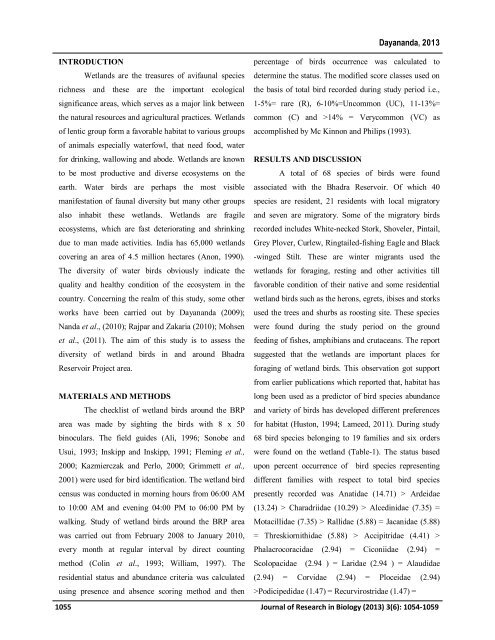Diversity of Wetland dependent birds around the Bhadra Reservoir Project (BRP) area, Karnataka
The study of bird species inhabiting certain wetlands around Bhadra Reservoir Project (BRP), Shivamogga, Karnataka was carried out from February 2008 to January 2010. The total of 68 species of wetland birds belonging to nineteen families and six orders. Of these, Anatidae (15%) and Ardidae (13%) have more than nine species. The diversity may be attributed the moderate volume of water storage, availability of food and assured protection to these birds. Additionally we recorded seven types of migratory birds visiting these ponds. Those include White-necked Stork, Shoveler, Pintail, Grey Plover, Curlew, Ringtailed-fishing Eagle and Black-winged Stilt. All these wetlands are important places for foraging activity of wetland birds. In order to protect these wetland birds, the wetlands should be conserved by controlling encroachment, pollution and other anthropogenic activities.
The study of bird species inhabiting certain wetlands around Bhadra Reservoir Project (BRP), Shivamogga, Karnataka was carried out from February 2008 to January 2010. The total of 68 species of wetland birds belonging to nineteen families and six orders. Of these, Anatidae (15%) and Ardidae (13%) have more than nine species. The diversity may be attributed the moderate volume of water storage, availability of food and assured protection to these birds. Additionally we recorded seven types of migratory birds visiting these ponds. Those include White-necked Stork, Shoveler, Pintail, Grey Plover, Curlew, Ringtailed-fishing Eagle and Black-winged Stilt. All these wetlands are important places for foraging activity of wetland birds. In order to protect these wetland birds, the wetlands should be conserved by controlling encroachment, pollution and other anthropogenic activities.
Create successful ePaper yourself
Turn your PDF publications into a flip-book with our unique Google optimized e-Paper software.
Dayananda, 2013<br />
INTRODUCTION<br />
<strong>Wetland</strong>s are <strong>the</strong> treasures <strong>of</strong> avifaunal species<br />
richness and <strong>the</strong>se are <strong>the</strong> important ecological<br />
significance <strong>area</strong>s, which serves as a major link between<br />
<strong>the</strong> natural resources and agricultural practices. <strong>Wetland</strong>s<br />
<strong>of</strong> lentic group form a favorable habitat to various groups<br />
percentage <strong>of</strong> <strong>birds</strong> occurrence was calculated to<br />
determine <strong>the</strong> status. The modified score classes used on<br />
<strong>the</strong> basis <strong>of</strong> total bird recorded during study period i.e.,<br />
1-5%= rare (R), 6-10%=Uncommon (UC), 11-13%=<br />
common (C) and >14% = Verycommon (VC) as<br />
accomplished by Mc Kinnon and Philips (1993).<br />
<strong>of</strong> animals especially waterfowl, that need food, water<br />
for drinking, wallowing and abode. <strong>Wetland</strong>s are known<br />
to be most productive and diverse ecosystems on <strong>the</strong><br />
earth. Water <strong>birds</strong> are perhaps <strong>the</strong> most visible<br />
manifestation <strong>of</strong> faunal diversity but many o<strong>the</strong>r groups<br />
also inhabit <strong>the</strong>se wetlands. <strong>Wetland</strong>s are fragile<br />
ecosystems, which are fast deteriorating and shrinking<br />
due to man made activities. India has 65,000 wetlands<br />
covering an <strong>area</strong> <strong>of</strong> 4.5 million hectares (Anon, 1990).<br />
The diversity <strong>of</strong> water <strong>birds</strong> obviously indicate <strong>the</strong><br />
quality and healthy condition <strong>of</strong> <strong>the</strong> ecosystem in <strong>the</strong><br />
country. Concerning <strong>the</strong> realm <strong>of</strong> this study, some o<strong>the</strong>r<br />
works have been carried out by Dayananda (2009);<br />
Nanda et al., (2010); Rajpar and Zakaria (2010); Mohsen<br />
et al., (2011). The aim <strong>of</strong> this study is to assess <strong>the</strong><br />
diversity <strong>of</strong> wetland <strong>birds</strong> in and <strong>around</strong> <strong>Bhadra</strong><br />
<strong>Reservoir</strong> <strong>Project</strong> <strong>area</strong>.<br />
RESULTS AND DISCUSSION<br />
A total <strong>of</strong> 68 species <strong>of</strong> <strong>birds</strong> were found<br />
associated with <strong>the</strong> <strong>Bhadra</strong> <strong>Reservoir</strong>. Of which 40<br />
species are resident, 21 residents with local migratory<br />
and seven are migratory. Some <strong>of</strong> <strong>the</strong> migratory <strong>birds</strong><br />
recorded includes White-necked Stork, Shoveler, Pintail,<br />
Grey Plover, Curlew, Ringtailed-fishing Eagle and Black<br />
-winged Stilt. These are winter migrants used <strong>the</strong><br />
wetlands for foraging, resting and o<strong>the</strong>r activities till<br />
favorable condition <strong>of</strong> <strong>the</strong>ir native and some residential<br />
wetland <strong>birds</strong> such as <strong>the</strong> herons, egrets, ibises and storks<br />
used <strong>the</strong> trees and shurbs as roosting site. These species<br />
were found during <strong>the</strong> study period on <strong>the</strong> ground<br />
feeding <strong>of</strong> fishes, amphibians and crutaceans. The report<br />
suggested that <strong>the</strong> wetlands are important places for<br />
foraging <strong>of</strong> wetland <strong>birds</strong>. This observation got support<br />
from earlier publications which reported that, habitat has<br />
MATERIALS AND METHODS<br />
The checklist <strong>of</strong> wetland <strong>birds</strong> <strong>around</strong> <strong>the</strong> <strong>BRP</strong><br />
<strong>area</strong> was made by sighting <strong>the</strong> <strong>birds</strong> with 8 x 50<br />
binoculars. The field guides (Ali, 1996; Sonobe and<br />
Usui, 1993; Inskipp and Inskipp, 1991; Fleming et al.,<br />
2000; Kazmierczak and Perlo, 2000; Grimmett et al.,<br />
2001) were used for bird identification. The wetland bird<br />
census was conducted in morning hours from 06:00 AM<br />
to 10:00 AM and evening 04:00 PM to 06:00 PM by<br />
walking. Study <strong>of</strong> wetland <strong>birds</strong> <strong>around</strong> <strong>the</strong> <strong>BRP</strong> <strong>area</strong><br />
was carried out from February 2008 to January 2010,<br />
long been used as a predictor <strong>of</strong> bird species abundance<br />
and variety <strong>of</strong> <strong>birds</strong> has developed different preferences<br />
for habitat (Huston, 1994; Lameed, 2011). During study<br />
68 bird species belonging to 19 families and six orders<br />
were found on <strong>the</strong> wetland (Table-1). The status based<br />
upon percent occurrence <strong>of</strong> bird species representing<br />
different families with respect to total bird species<br />
presently recorded was Anatidae (14.71) > Ardeidae<br />
(13.24) > Charadriidae (10.29) > Alcedinidae (7.35) =<br />
Motacillidae (7.35) > Rallidae (5.88) = Jacanidae (5.88)<br />
= Threskiornithidae (5.88) > Accipitridae (4.41) ><br />
every month at regular interval by direct counting Phalacrocoracidae (2.94) = Ciconiidae (2.94) =<br />
method (Colin et al., 1993; William, 1997). The Scolopacidae (2.94 ) = Laridae (2.94 ) = Alaudidae<br />
residential status and abundance criteria was calculated (2.94) = Corvidae (2.94) = Ploceidae (2.94)<br />
using presence and absence scoring method and <strong>the</strong>n >Podicipedidae (1.47) = Recurvirostridae (1.47) =<br />
1055 Journal <strong>of</strong> Research in Biology (2013) 3(6): 1054-1059

















